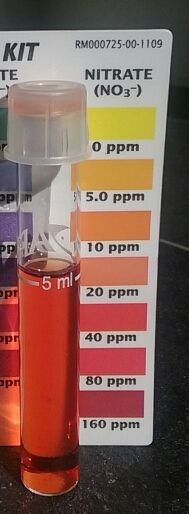A 50% each day is fine. I am assuming your other parameters (GH, pH) between tap and tank water are relatively close.
Nitrate comes from organics; agricultural runoff around farms for example is a common source of nitrate in well water. So basically anything that adds organics to the aquarium has the potential to increase nitrate. Fish load, not just numbers but size (more fish, or larger fish, obviously produce more organic waste), fish foods, and decaying organics like fish excrement in the substrate, filter, etc. are the prime sources. Now, obviously from this you can see that nitrates will be occurring always in every aquarium with live fish that are being fed. But the fewer fish, the lower will be the nitrates. And perhaps to be clear I should explain that nitrates do not appear on their own; they result from the second stage of nitrification--ammonia is changed into nitrite which is then changed into nitrate. I'll come back to this momentarily.
Live plants help not so much by taking up nitrates, but by taking up ammonia/ammonium in something of a competition with the nitrifying bacteria. But when plants take up the ammonia/ammonium, nitrite is not produced, and thus no nitrate. So with lots of plants, nitrates will usually be lower than without. But one cannot jump onto this, because all the other biological and chemical factors are still part of the processes. Though having said that, many of us with fairly heavily planted tanks, using the natural (meaning, no added CO2 or high light) method do have nitrates at zero or slightly above. However, the fish do still play into the equation. Most aquarium plants prefer ammonium over nitrate, and will begin taking up nitrate only when the ammonium is exhausted. There is some suggestion that they may actually prefer nitrite over nitrate, but studies in this area are few and many think inconclusive. But no one really doubts that ammonia/ammonium is the first choice of plants. The reason is that when they take up nitrate (or nitrite if they do), they must change this back to ammonium, and this takes more energy, so it is sort of a last resort.
Water changes are the quickest and usually most effective way of eliminating nitrates, or at least reducing them. Provided nitrates are not occurring rapidly, this can work well. Vacuuming into the substrate during the water changes, in open areas, will remove a lot of the decomposing organics, further lowering nitrates. Keeping the filter clean also. And this leads into de-nitrification.
This is the final stage in the nitrogen cycle. Many will stop at nitrates, thinking them "safe," and ignore the next stage. But nitrate can be changed back into nitrogen gas and released into the atmosphere (this is de-nitrification). Nitrate can also be turned into oxygen by certain anaerobic bacteria. De-nitrification is becoming much more talked about in filtration these days. Seachem (I believe) and some other manufacturers are producing biological filter media that they claim specifically provides for de-nitrification. Of course, this stage can become overloaded too, again due primarily to the fish load and feeding.
Some additives, esp plant fertilizers, may add nitrate. This should be insignificant, unless one is running a high-tech method planted tank and dosing nitrates as a source of nitrogen.
Byron.


